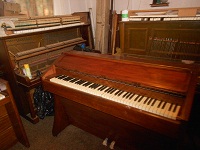 Debbie founded the Little Saints Pre-School on the Kensington/Bez Valley border in 2001. The school is run in partnership with the Bethany shelter for abused women in Bertrams. Madina started the Bismillah Pre-School in Bez Valley in 2003. Both schools adapt themselves to the realities of the neighbourhood.
Debbie founded the Little Saints Pre-School on the Kensington/Bez Valley border in 2001. The school is run in partnership with the Bethany shelter for abused women in Bertrams. Madina started the Bismillah Pre-School in Bez Valley in 2003. Both schools adapt themselves to the realities of the neighbourhood.  The schools take children from birth to six years of age. There are 88 children at the Little Saints Pre-School and 90 at Bismillah. Little Saints opens its doors at 07.00 in the morning and closes at 17.30. Bismillah is open from 6.00 a.m. to 6.00 p.m. Afterschool care is offered to primary school children.
The schools take children from birth to six years of age. There are 88 children at the Little Saints Pre-School and 90 at Bismillah. Little Saints opens its doors at 07.00 in the morning and closes at 17.30. Bismillah is open from 6.00 a.m. to 6.00 p.m. Afterschool care is offered to primary school children.Most Bismillah parents are single mothers, generally domestic workers or street traders. More and more Little Saints parents, which is less than a kilometer away, are single fathers or from families where fathers are doing more of the parenting than mothers.
Children at the schools live in Hillbrow, Yeoville, Jeppestown, Bez Valley, Bertrams, Malvern, Kensington. The majority of children at the Bismillah school live in Bez Valley.
 Communication is a daily challenge. Many of the children do not speak English or any other South African language, and nor do their parents. The children are from South Africa, Ethiopia, Sudan, Uganda, Nigeria, Zimbabwe, Angola, Mozambique, Zambia, DRC, Kenya, Malawi, and India. They come and go, generally because parents lose their jobs or get evicted from houses and are forced to relocate.
Communication is a daily challenge. Many of the children do not speak English or any other South African language, and nor do their parents. The children are from South Africa, Ethiopia, Sudan, Uganda, Nigeria, Zimbabwe, Angola, Mozambique, Zambia, DRC, Kenya, Malawi, and India. They come and go, generally because parents lose their jobs or get evicted from houses and are forced to relocate. 
“We live in an environment where people struggle to survive. Either there is a single mother who needs to work or we have a lot of single fathers in this school because the mothers are into drugs or alcohol so they are not involved in the child’s life... So you need to be able to educate the child to take care of themselves …If you can empower the child to feel confident enough to speak up if they are not comfortable with what is going on, then you have given them a skill for life,” Debbie says.
She stresses that a parent’s occupation has nothing to do with good parenting. The father of a child who is no longer at the school was clearly a drug dealer, she tells me. He attended all the talks and meetings at the school and implemented what he learned, with very positive consequences for his child.
 Single mothers work very long hours and are too exhausted to be good mothers. “There is a lot of neglect,” Madina says. “The child will come dirty, empty bag, crying and not happy at school. There is no love, no attention. Most are living in backrooms and rooms in houses, sharing rooms. Sometimes there are eight families in one house… I have one child right now where the mother is going under to depression because of her condition. Her rent is high. She is selling on the streets in town. She comes from Congo. I am looking at sponsoring the child because this is someone you can see is not lying. This is a reality…She comes in tears, she can’t pay.”
Single mothers work very long hours and are too exhausted to be good mothers. “There is a lot of neglect,” Madina says. “The child will come dirty, empty bag, crying and not happy at school. There is no love, no attention. Most are living in backrooms and rooms in houses, sharing rooms. Sometimes there are eight families in one house… I have one child right now where the mother is going under to depression because of her condition. Her rent is high. She is selling on the streets in town. She comes from Congo. I am looking at sponsoring the child because this is someone you can see is not lying. This is a reality…She comes in tears, she can’t pay.”Pre-schools in the area support one another and share resources. “We speak to one another. Debbie donates extra toys and invites us to functions and courses. She does a lot for the area,” Madina says.
School fees are not sufficient to cover the cost of food for the children and salaries.
“People must open their hearts. A lot of people are struggling… In the last two years things have got worse and worse. Most end up sending their children to the villages because they can’t afford to pay,” Madina says.
If you would like to sponsor a child or make a donation to one of these pre-schools, please contact me and I will facilitate this (melodyemmett@gmail.com)
























